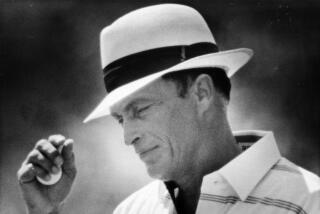It’s a Shot Heard ‘Round World--Far East and West
- Share via
BIRMINGHAM, Mich. — The Chinese, they are a clever race. They invented gunpowder, spaghetti, the egg roll, soy sauce and the fortune cookie. They discovered rice, built the Great Wall--and now they’re the first ever to pioneer the U.S. Open double-eagle. It’s a little refinement they never showed Marco Polo, but they put it on display for the flower of U.S. golf in the tournament at Oakland Hills here Thursday. No Westerner had ever done it, not Ben Hogan, Jack Nicklaus or Arnie Palmer, and not Severiano Ballesteros, Sam Snead or Bobby Jones, either.
A double-eagle, for those of you unfamiliar with this ancient Oriental trick, is a three-under-par score on a hole. It is the rarest shot in all of golf, very seldom made by Caucasians and not commonplace in mainland China either.
Confucius, of course, would say, “Hit the ball hard and let the chips fall where they may.” Or, “Hit the ball harder and no need to chip at all.” That’s what Tze-Chung Chen did with a 3-wood here Thursday afternoon, almost single-handedly turning a routine, teeth-clenching U.S. Open opening round into a Chinese New Year’s. Known hereafter in honorable lore as the Year of the Spoon.
It had been a standard first round for a U.S. Open to that point, which is to say it was beginning to look not only as if no one would win it, but also as if nobody would make the cut.
It was looking less like a tournament than a death march. Player after player stumbled hollow-eyed onto the 18th green looking like men who had just seen their own ghosts. It was golf’s version of Bonaparte’s Retreat as, one after the other, players fell back, jettisoning putters, muttering ancient curses and glaring at shots that landed not in holes but water, sand and the laps of customers sitting in the front rows of greenside grandstands.
You figured you had to be Nero to enjoy this spectacle up to then. The lions were feasting on the remains of these Christians in sleeveless sweaters and cleated soles. It wasn’t a contest--unless you consider the bombing of Rotterdam or the eruption of Mt. St. Helens a contest. Anyone who watched had to have a taste for snuff movies or 10-car pileups. The things the course was doing to all those nice, blond boys from Brigham Young and Wake Forest was depressing.
The ancient Chinese, and modern Taiwanese, trick of a 3-wood to a guarded green by Tze-Chung Chen changed all that.
Before that, the inscrutable Occidentals had been turning the 527-yard No. 2 hole into a wall-to-wall hall of horrors, shooting 5s, 6s and even a random 4 on it if they were lucky. Chen shot a 2. He did it with a 3-wood that soared 256 yards through the damp Michigan air, hit in front of the green, rolled on and plunked into the hole.
This shot not only changed T.C. Chen’s round, it changed the tournament. Almost at once, scores began to lower all over the course. Before then, no player had broken par, but all of a sudden, Fred Couples was shooting a 66, and Tom Kite, Mike Reid, Andy Bean, Jay Haas and Rick Fehr were breaking par.
Chen had broken the back of the dragon. Before his 2, most of the field seemed to have been content just to defend itself against the course Hogan called a “monster.” Thereafter, they all went to attack.
A U.S. Open is a unique sporting event, anyway. Even the Anglo-Saxon names have a faint mystery to them. Among those not able to solve the puzzles of its 18 holes were such household names as Robert Pancratz, Daniel O’Neill, Jeff Hunter, Lee Chill Jr. and Chris Townes. But it also kicked around such familiar TV staples as Ben Crenshaw, Jack Nicklaus, Jerry Pate, Tom Watson and Lee Trevino, to say nothing of British Open winner Bill Rogers, who weighed in with an 81.
But to T.C., the monster just looked like two guys wearing a paper dragon. He flattened it with one swing.
American sports likes to affix the epithet Chinese to flukish happenstances. A Chinese home run is a mis-hit that goes over a too-close fence. A Chinese fire drill is a play that’s found too many players running the wrong way.
So, when Chen shot to three-under-par on one shot, it was freely wisecracked that this would give him a 75 for the day. It gave him a 65 for the day. He calmly tacked two more birdies on his score, and a Chinese double-eagle is henceforth a fire drill that leads the U.S. Open, or maybe wins it. When Gene Sarazen hit his double-eagle in the Masters in 1935, it was known as the “double-eagle heard ‘round the world.” But you can bet T.C. Chen’s will be heard in places they haven’t heard about Sarazen’s yet.
More to Read
Go beyond the scoreboard
Get the latest on L.A.'s teams in the daily Sports Report newsletter.
You may occasionally receive promotional content from the Los Angeles Times.










